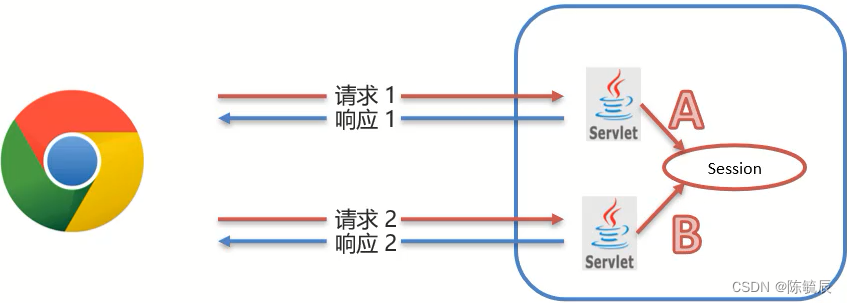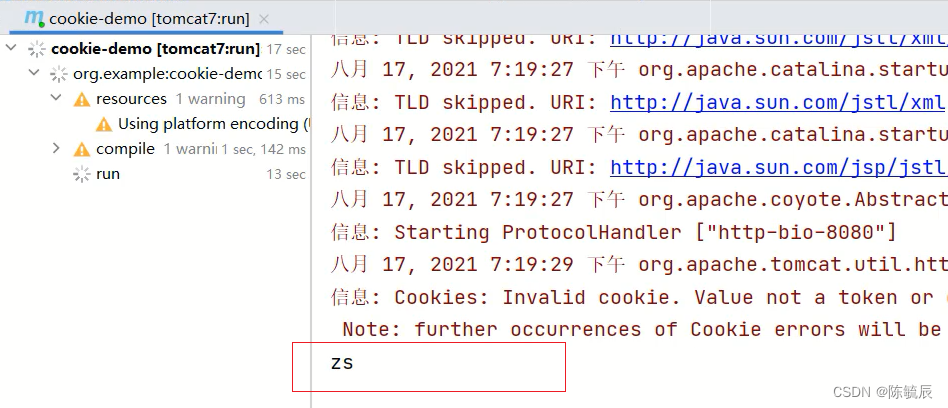-
Session
Session
1.概念
Session:服务端会话跟踪技术:将数据保存到服务端。- Session是存储在服务端而Cookie是存储在客户端
- 存储在客户端的数据容易被窃取和截获,存在很多不安全的因素
- 存储在服务端的数据相比于客户端来说就更安全
2.Session的工作流程

- 在服务端的AServlet获取一个Session对象,把数据存入其中
- 在服务端的BServlet获取到相同的Session对象,从中取出数据
- 就可以实现一次会话中多次请求之间的数据共享了
- 现在最大的问题是如何保证AServlet和BServlet使用的是同一个Session对象(在原理分析会讲解)?
3.Session的基本使用 - 在Javaee中提供了HttpSession接口,来实现一次会话的请求之间数据共享功能。
- 具体的使用步骤为:
-
- 获取Session对象,使用的是request对象
HttpSession session = request.getSession();- 1
- Session对象提供的功能:
-
- 存储数据到session域中
void setAttribute(String name,Object o)- 根据key,获取值
Object getAttribute(String name)- 根据key,删除该键值对
void removeAttribute(String name)
介绍完Session相关的API后,接下来通过一个案例来完成对Session的使用,具体实现步骤为:
1)创建名为SessionDemo1的Servlet类
@WebServlet("/demo1") public class SessionDemo1 extends HttpServlet { @Override protected void doGet(HttpServletRequest request, HttpServletResponse response) throws ServletException, IOException { } @Override protected void doPost(HttpServletRequest request, HttpServletResponse response) throws ServletException, IOException { this.doGet(request, response); } }- 1
- 2
- 3
- 4
- 5
- 6
- 7
- 8
- 9
- 10
- 11
- 12
2)创建名为SessionDemo2的Servlet类
@WebServlet("/demo2") public class SessionDemo2 extends HttpServlet { @Override protected void doGet(HttpServletRequest request, HttpServletResponse response) throws ServletException, IOException { } @Override protected void doPost(HttpServletRequest request, HttpServletResponse response) throws ServletException, IOException { this.doGet(request, response); } }- 1
- 2
- 3
- 4
- 5
- 6
- 7
- 8
- 9
- 10
- 11
- 12
3)SessionDemo1:获取Session对象、存储数据
@WebServlet("/demo1") public class SessionDemo1 extends HttpServlet { @Override protected void doGet(HttpServletRequest request, HttpServletResponse response) throws ServletException, IOException { //存储到Session中 //1. 获取Session对象 HttpSession session = request.getSession(); //2. 存储数据 session.setAttribute("username","zs"); } @Override protected void doPost(HttpServletRequest request, HttpServletResponse response) throws ServletException, IOException { this.doGet(request, response); } }- 1
- 2
- 3
- 4
- 5
- 6
- 7
- 8
- 9
- 10
- 11
- 12
- 13
- 14
- 15
- 16
(4)SessionDemo2:获取Session对象、获取数据
@WebServlet("/demo2") public class SessionDemo2 extends HttpServlet { @Override protected void doGet(HttpServletRequest request, HttpServletResponse response) throws ServletException, IOException { //获取数据,从session中 //1. 获取Session对象 HttpSession session = request.getSession(); //2. 获取数据 Object username = session.getAttribute("username"); System.out.println(username); } @Override protected void doPost(HttpServletRequest request, HttpServletResponse response) throws ServletException, IOException { this.doGet(request, response); } }- 1
- 2
- 3
- 4
- 5
- 6
- 7
- 8
- 9
- 10
- 11
- 12
- 13
- 14
- 15
- 16
- 17
(5)启动测试,
- 先访问
http://localhost:8080/cookie-demo/demo1,将数据存入Session - 在访问
http://localhost:8080/cookie-demo/demo2,从Session中获取数据 - 查看控制台

通过案例的效果,能看到Session是能够在一次会话中两次请求之间共享数据。小结
至此Session的基本使用就已经完成了,重点要掌握的是:
-
Session的获取
HttpSession session = request.getSession();- 1
-
Session常用方法的使用
void setAttribute(String name, Object o) Object getAttribute(String name)- 1
- 2
**注意:**Session中可以存储的是一个Object类型的数据,也就是说Session中可以存储任意数据类型。
介绍完Session的基本使用之后,那么Session的底层到底是如何实现一次会话两次请求之间的数据共享呢?
-
相关阅读:
2023 版 Java和python开发线性代数探索
【MindSpore易点通】模型测试和验证
2022最新分享:企业级Android Framework学习路线,打破面试“面试造火箭,入厂拧螺丝“难点
Vue3 响应式原理
Java手写背包问题算法应用拓展案例
IPv4用的好好的,为什么我们要换IPv6?
山东省软件设计大赛-比赛经历
中级职称有什么作用和好处?为什么要办一个职称?
[论文阅读]A ConvNet for the 2020s
基于Springboot社区疫情防控系统设计与实现 毕业设计开题报告
- 原文地址:https://blog.csdn.net/qq_53037676/article/details/126581492
